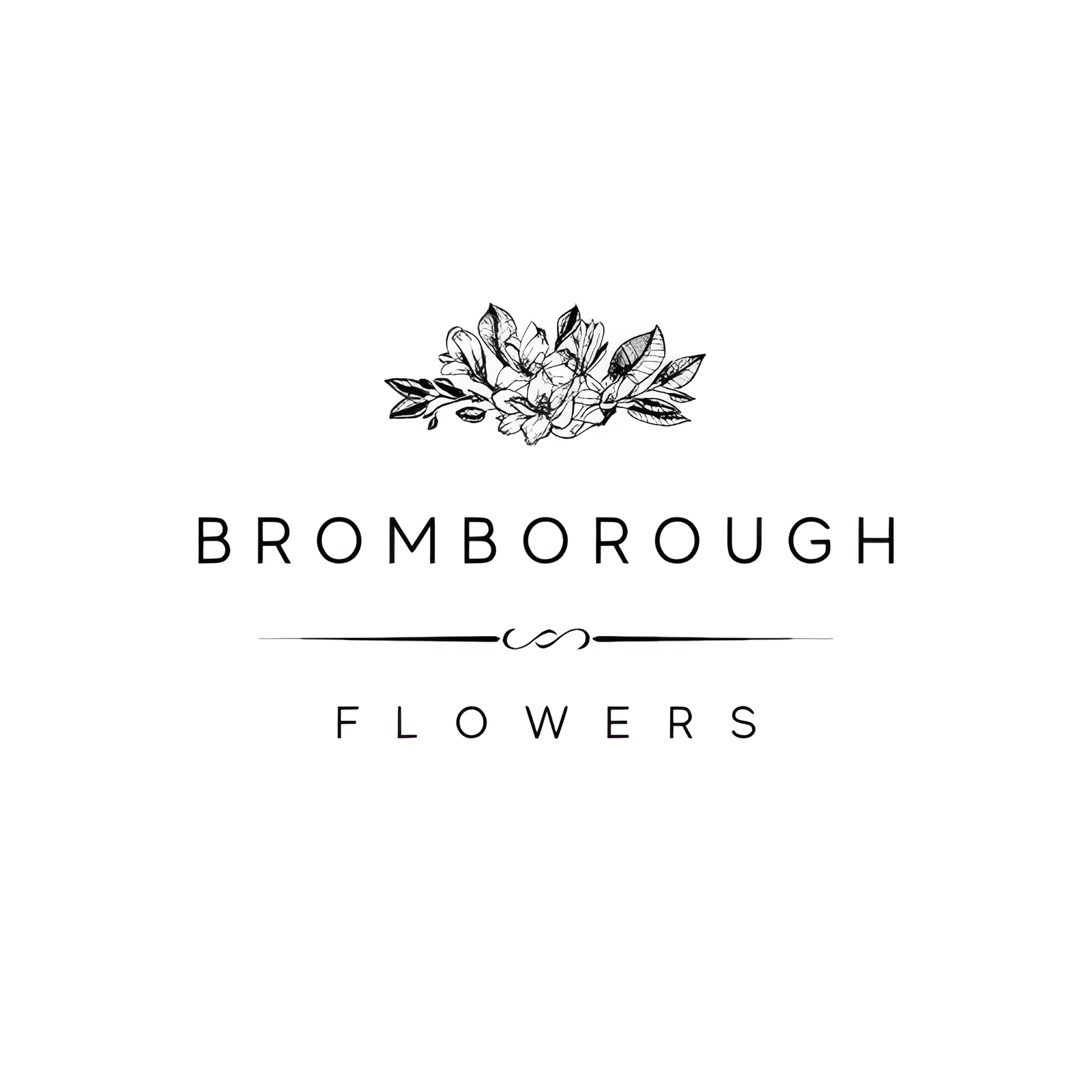The Clematis, often admired for its diverse shades and unique starry and tulip-shaped blooms, stands out as a versatile choice in wedding decor. Its ability to infuse movement and elegance into any arrangement makes it a sought-after addition to bouquets, centerpieces, and bridal accessories. This discussion will explore the various attributes that make Clematis an exceptional choice for wedding floral arrangements, from its wide color palette to its cultural significance. What particularly sets Clematis apart, and how can it be best utilized in different wedding themes?
Flower Overview
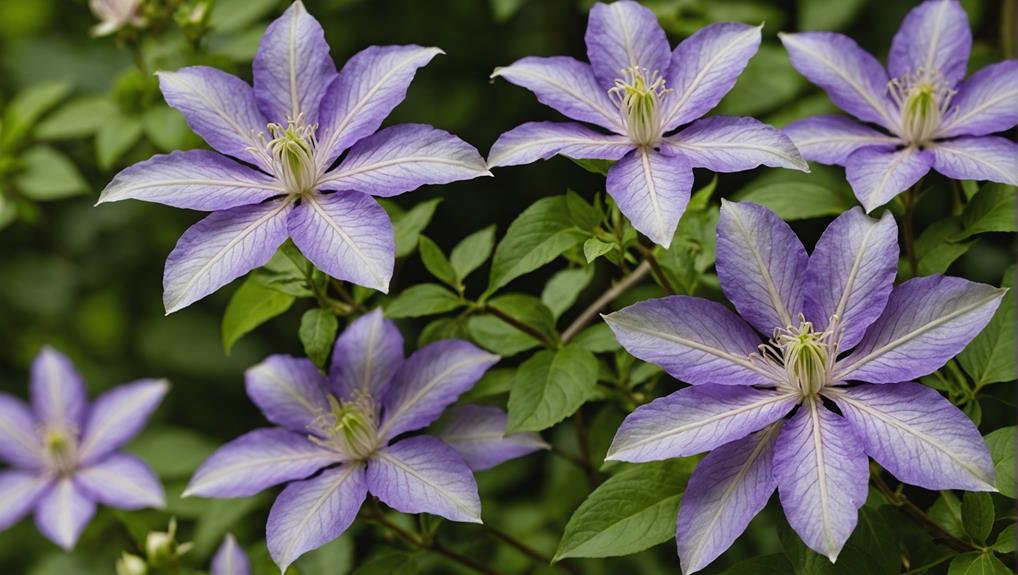
Originating in Japan and celebrated for their vibrant climbing hues, Clematis flowers have become a staple in both garden landscapes and wedding arrangements. These beautiful blooms have garnered widespread admiration for their versatility and aesthetic appeal, making them a preferred choice for wedding flowers.
Clematis flowers come in nearly every color, allowing them to complement various wedding themes and styles seamlessly.
One of the most alluring aspects of Clematis flowers is their ability to add movement and elegance to floral arrangements. Whether incorporated into bouquets, centerpieces, or archways, they lend a dynamic and sophisticated touch that enhances the overall ambiance of the event.
Their unique appearance guarantees that each arrangement stands out, contributing to the memorability of wedding decor.
The broad color palette of Clematis flowers, ranging from soft pastels to vivid shades, provides endless opportunities for creativity. This versatility makes them ideal for any wedding setting, from rustic outdoor ceremonies to grand indoor receptions.
Their enduring popularity in gardens translates beautifully into wedding arrangements, where their charm and elegance can be fully appreciated.
Physical Description
Clematis Beautiful Bride PP23292, a texensis hybrid, is distinguished by its unique open, starry shape and striking ruby red sepals that form tulip-shaped flowers. These blooms measure approximately 4 inches in size, making them an enchanting addition to any floral arrangement.
The plant itself can grow to a height of 5-7 feet, creating an impressive vertical display that is particularly well-suited for wedding settings. This clematis variety thrives in hardiness zones 4-11, demonstrating versatility across a range of climates. It is deer resistant, which adds to its appeal for outdoor events and garden settings.
Clematis Beautiful Bride PP23292 blooms in the summer, ensuring vibrant, eye-catching flowers during the peak wedding season. Requiring a pruning level of 3, this clematis is relatively low-maintenance and wilt-resistant, making it a practical choice for both professional florists and amateur gardeners.
The plant flourishes in full sun to partial shade, allowing for flexible placement in various garden designs. Its robust nature and stunning physical characteristics make Clematis Beautiful Bride PP23292 an exceptional choice for those seeking to add a touch of elegance and natural beauty to their wedding decor.
Available Colour Varieties
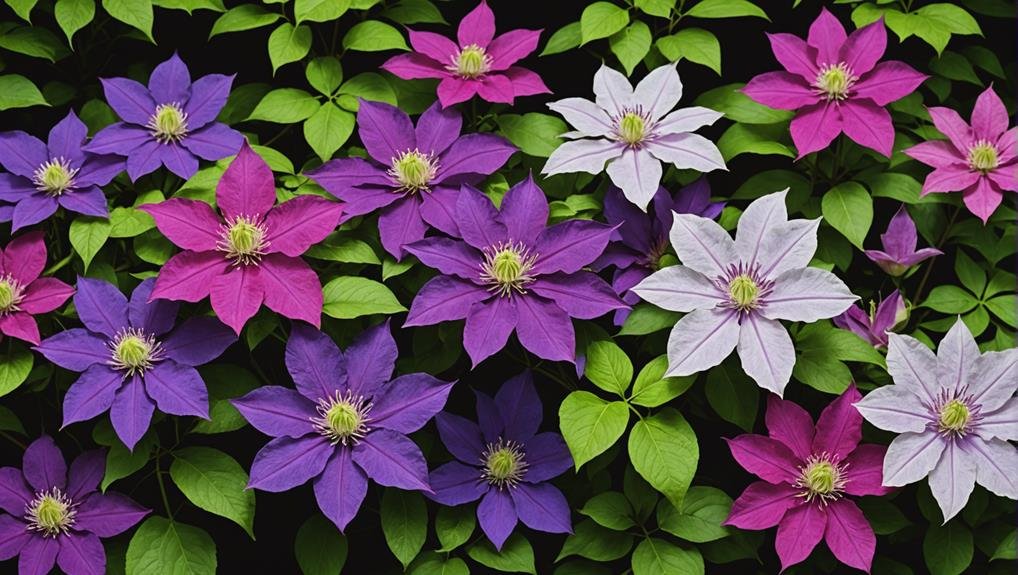
In addition to its striking physical characteristics, Clematis Beautiful Bride PP23292 is part of a diverse family of clematis flowers that come in an array of enchanting colors, including white, blue, red, plum, and blush. This wide color palette provides versatility and creativity for wedding floral arrangements, allowing for seamless color pairing and bouquet options that enhance the overall aesthetic of the event.
The white variety, often associated with purity and elegance, is a popular choice for bridal accessories and bridesmaid bouquets. Blue clematis can introduce a touch of tranquility and sophistication, while red varieties bring vibrancy and passion to any setting. Plum-colored clematis offers a rich, regal hue, perfect for adding depth to reception decor. Blush, with its soft, romantic tone, is ideal for creating a dreamy and delicate ambiance.
These color options enable brides and wedding planners to match clematis flowers with various wedding themes and color schemes. Whether used as the focal point in a bridal bouquet or as complementary elements in table centerpieces, clematis flowers provide endless possibilities for unique and memorable floral arrangements. Their diverse colors make them a favored choice for those seeking to elevate their wedding decor.
Latin Name and Taxonomy
The Latin name for this stunning flower is Clematis Lovely Bride PP23292, a texensis hybrid that belongs to the Ranunculaceae family. This clematis variety is distinguished by its impressive star-shaped, single blooms, which can reach the size of your face and are known for their striking white color. As a member of the Ranunculaceae family, Clematis Lovely Bride exemplifies the diverse and intricate nature of this botanical classification.
Clematis taxonomy plays a vital role in understanding the plant characteristics that make this flower so special. Particularly, Clematis Lovely Bride PP23292 thrives in hardiness zones 4-9 and has a moderate growth rate, making it a versatile choice for various climates and garden settings. When planting, it is important to place the clematis 2-4 inches deeper than the current crown to promote optimal growth.
Below is a table summarizing key aspects of Clematis Lovely Bride PP23292:
| Aspect | Detail | Note |
|---|---|---|
| Latin Name | Clematis Lovely Bride PP23292 | A texensis hybrid |
| Family | Ranunculaceae | Known for star-shaped flowers |
| Growth Rate | Medium | Suitable for hardiness zones 4-9 |
| Planting Depth | 2-4 inches deeper than current crown | Important for best growth |
Understanding the botanical classification and plant characteristics of Clematis Lovely Bride provides valuable insights for selecting and cultivating this graceful flower.
Geographical Origins
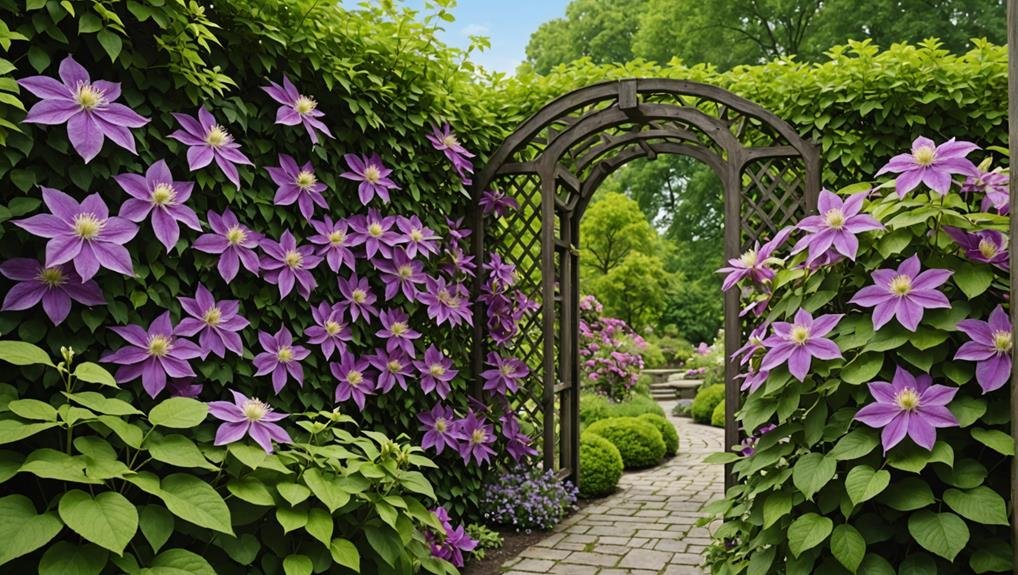
Originating in Japan, clematis flowers later spread to Europe, becoming popular garden plants celebrated for their vibrant climbing hues and unique beauty. The historical significance of clematis is deeply rooted in these regions, where it was cherished for both ornamental and symbolic meanings.
As global distribution increased, clematis gained horticultural importance, gracing gardens and wedding arrangements worldwide.
Clematis flowers have undergone various evolutionary adaptations, enabling them to thrive in diverse climates and conditions. These adaptations, combined with their striking appearance, have solidified their place in global horticulture.
The environmental impact of cultivating clematis is generally positive, as they provide habitat and food for various pollinators and insects, contributing to the ecosystem's health.
Key points to bear in mind about the geographical origins of clematis include:
- Symbolic meanings and historical significance: Clematis have held various symbolic meanings in different cultures, often associated with beauty and ingenuity.
- Global distribution and horticultural importance: Widely distributed across the globe, clematis are integral to both gardens and wedding floristry.
- Evolutionary adaptations and environmental impact: These flowers have adapted to numerous environments, supporting local ecosystems and biodiversity.
Understanding the geographical origins of clematis enhances our appreciation of their beauty and versatility in floral design.
Season Availability
Clematis flowers mainly bloom in the spring, offering their vibrant colors and unique starry shapes during this peak season. This makes them an excellent choice for spring weddings, where their natural beauty can be showcased to its fullest.
The clematis availability during the wedding season is particularly advantageous for those looking to incorporate these blooms into their floral arrangements, providing a fresh and elegant touch to various aspects of wedding decor.
The peak season for clematis flowers aligns perfectly with the timing of many spring weddings, making them a sought-after choice for bridal bouquets, centerpieces, and other decorative elements. Their stunning hues and distinctive forms add a layer of sophistication and charm, enhancing the overall aesthetic of wedding ceremonies and receptions.
As seasonal flowers, clematis blooms are not only beautiful but also symbolize the renewal and blossoming that spring brings, adding a deeper meaning to wedding celebrations.
Incorporating clematis into wedding decor allows for versatile and creative floral designs. Whether used as a focal point or a complementary element, their presence in spring guarantees that couples can achieve a fresh and vibrant look that resonates with the season's spirit.
Growing Conditions
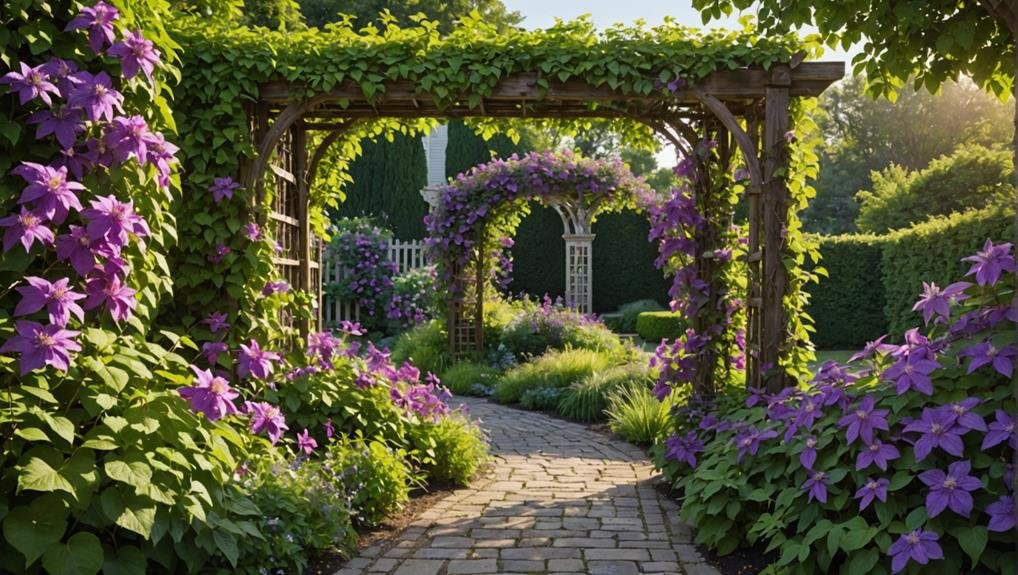
For prime growth, Clematis Beautiful Bride PP23292 requires specific growing conditions that cater to its hardiness and blooming potential. Thriving in USDA hardiness zones 4-9, this versatile vine can adapt to a wide range of climates. Ideal soil preparation involves planting the vine 2-4 inches deeper than the crown to encourage robust root development and stability.
Proper care and maintenance are essential for maximizing the beauty and health of Clematis Beautiful Bride PP23292. An effective watering schedule is crucial; the soil should remain consistently moist but not waterlogged. Trellis support is recommended to guide the vine's growth and showcase its blooms effectively.
Soil preparation and pruning: Ensure the soil is well-draining and rich in organic matter. Regular pruning helps maintain shape and encourages new growth.
Watering schedule and trellis support: Maintain consistent moisture levels and provide a sturdy structure for the vine to climb.
Pest control and fertilizing techniques: Use organic or chemical treatments to manage pests and apply balanced fertilizers to support vigorous growth.
Winter care involves mulching to protect the roots from frost. With a medium growth rate and reaching heights of 5-9 feet, this clematis is an eye-catching addition to any garden.
Cultural Significance
Throughout history, clematis flowers have held a prominent place in various cultures, symbolizing mental beauty and the joy of travel. Originating in Japan, these vibrant blooms have traversed continents, establishing their presence in European gardens centuries ago. Clematis flowers are revered not just for their visual appeal but also for their rich symbolic meanings. In many cultures, they are seen as emblems of ingenuity and the pursuit of knowledge, often associated with the mental journey one undertakes in life.
Their historical significance is deeply rooted in traditional ceremonies, particularly in Eastern cultures where they were used to adorn temples and homes during significant festivals. The Japanese, for instance, regard clematis flowers as symbols of art and creativity, often integrating them into various artistic expressions and cultural rituals. In Europe, these flowers were historically included in traditional ceremonies to symbolize the intertwining of destinies, reflecting their climbing nature.
The duality of clematis, representing both the beauty of the mind and the joy of exploration, has cemented its place in cultural narratives across the globe. This enduring legacy highlights the flower's versatility and depth, making it a cherished element in both historical and contemporary settings.
Typical Use in Weddings
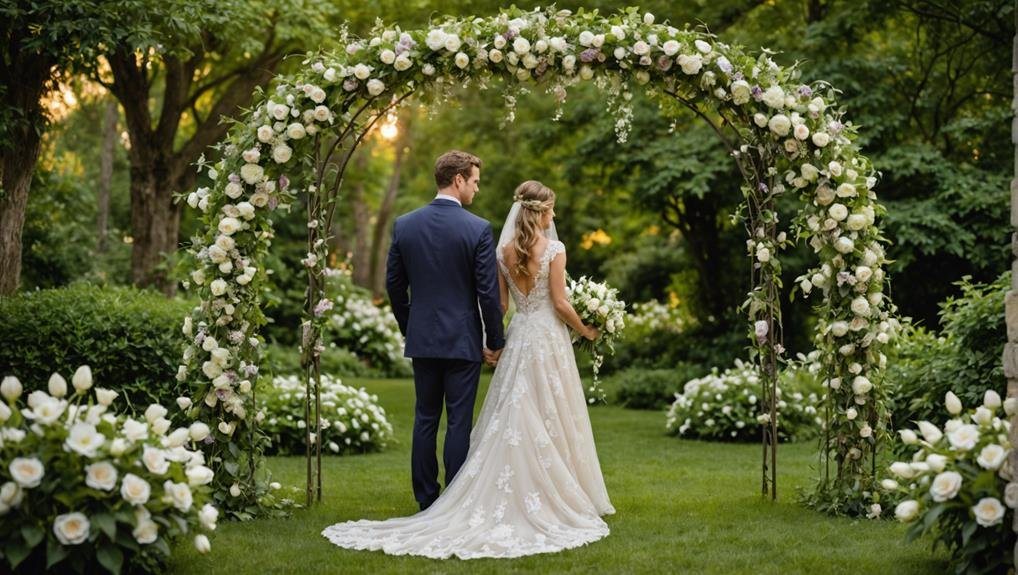
In wedding decor, these versatile blooms are often utilized for their vibrant colors and ability to enhance both bouquets and centerpieces. Clematis flowers, known for their unique beauty and climbing hues, are a popular choice in various wedding arrangements. Their ability to add movement and a touch of garden-inspired elegance makes them a favorite across different wedding styles and seasons.
Clematis flowers are frequently incorporated into decorative arrangements, adding an element of charm and sophistication. They are also ideal for bridal hairpieces, providing a delicate yet striking accent to the bride's overall look. Additionally, these blooms can enhance table centerpieces, creating visually appealing and cohesive designs that tie the entire wedding theme together.
Apart from traditional uses, clematis flowers make stunning ceremony backdrops, offering a lush and vibrant setting for exchanging vows. They also serve well in smaller, more intimate applications such as corsages and boutonnieres, ensuring that every member of the bridal party carries a piece of this elegant flower.
- Decorative arrangements
- Bridal hairpieces
- Table centerpieces
Alternative Flower Types
While clematis flowers offer a unique and elegant touch to wedding decor, exploring different flower varieties can provide additional options for creating stunning floral arrangements. One notable floral substitute is the peony, renowned for its lush, full blooms and romantic charm. Available in various colors, peonies can be incorporated into creative bouquets for a timeless appearance.
Roses, another traditional selection, bring elegance and flexibility to wedding florals. Their wide array of shades allows for distinctive arrangements that can complement any wedding theme. For those looking for a more exotic touch, orchids offer an elegant and modern feel. Recognized for their intricate shapes and vibrant colors, orchids can enhance any floral design.
Hydrangeas, with their abundant clusters, are excellent for making bold statements in centerpieces or bridal bouquets. Their capacity to absorb dye makes them highly adaptable to personalized color schemes.
Lastly, sunflowers provide a cheerful and rustic substitute. Their vibrant yellow petals and robust stems make them perfect for outdoor or barn weddings.
Exploring these floral alternatives guarantees that brides and grooms can discover the perfect blooms to match their style and venue, ensuring memorable and visually appealing wedding decor.
